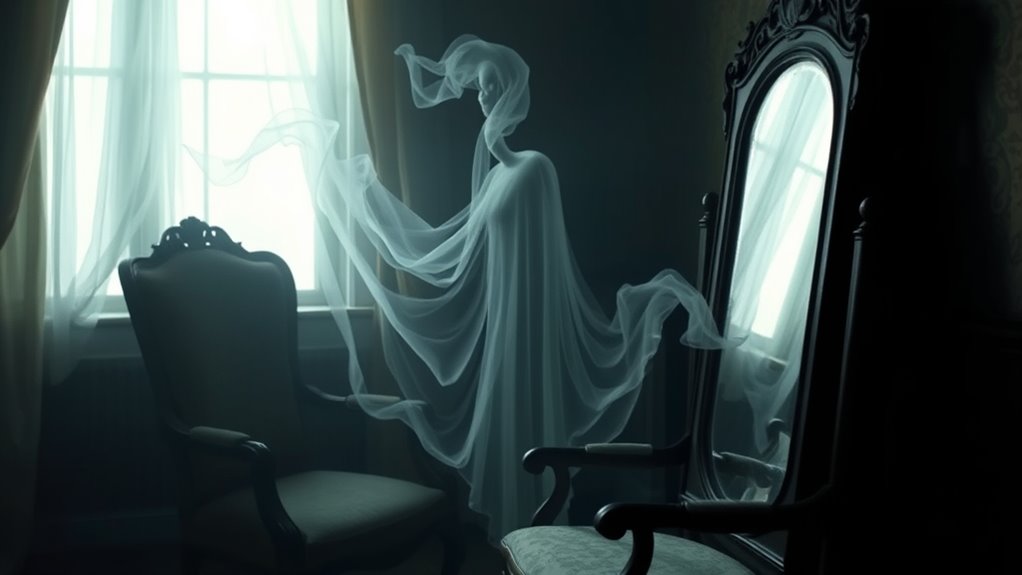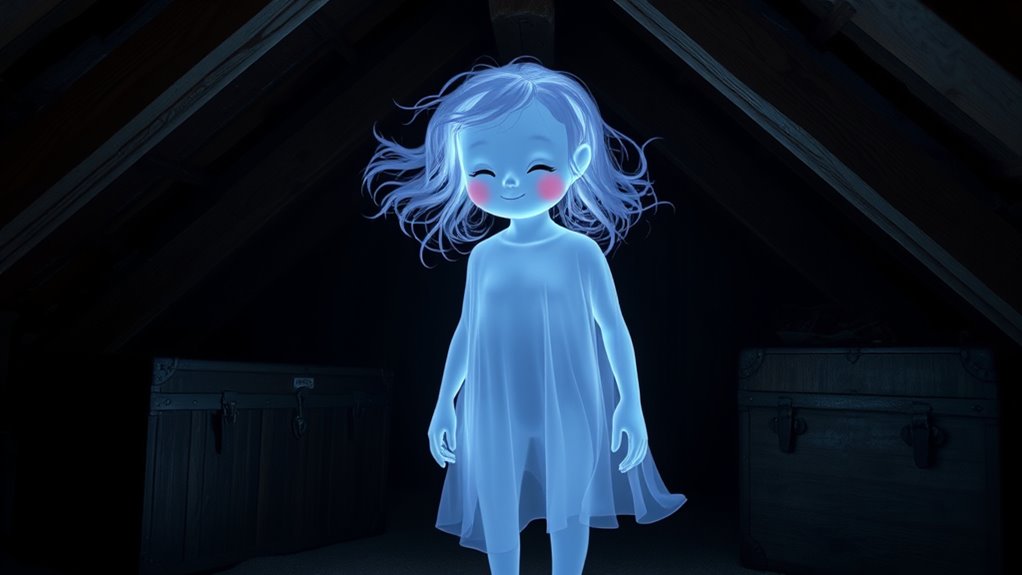Many people believe all ghosts are evil and harmful, but that’s a common myth. Most spirits are actually benign, confused, or seeking connection rather than revenge. Not every haunted experience involves malevolent entities—many are friendly or simply lost. Recognizing this helps you see spirits in a more positive light. If you stay curious, you’ll discover that not all spirits fit the scary story stereotypes and that peaceful encounters are more common than you think.
Key Takeaways
- Many spirits are benign or seeking connection, not malevolent, contradicting common fear-based perceptions.
- Spirit communication often reveals messages of guidance or comfort, highlighting their peaceful nature.
- Media and stories tend to sensationalize spirits as evil, fueling myths that are not supported by many real encounters.
- Understanding spirits as diverse—some lost, confused, or helpful—helps dispel the myth of inherent evil.
- Recognizing the benign aspects of spirits can foster respectful, positive interactions and reduce fear.

Many people associate ghosts with evil spirits lurking in the shadows, but this widespread belief is actually a myth rooted in fear and misunderstanding. Throughout history, tales of haunted houses and malevolent apparitions have fueled the idea that all spirits are dangerous and hostile. However, the reality is far more nuanced. Not every ghost is a vengeful or malicious presence; many are simply lost souls or entities seeking connection. Understanding this shifts your perspective and allows you to see spirits in a different light, especially when it comes to spirit communication.
When you explore haunted houses, you often hear stories that paint spirits as scary and harmful. But these places are also rich with stories of spirits that communicate in gentle or benign ways. Many haunted houses are believed to be inhabited by spirits that aren’t malevolent but rather confused or longing for closure. These spirits might respond to your attempts at communication, offering messages or signs rather than threats. Spirit communication, through mediums or even personal experiences, reveals that not all spirits want to harm you. In fact, many are simply trying to make contact, share their stories, or provide guidance. Recognizing this helps dispel the myth that all ghosts are evil, opening your mind to the possibility that some spirits are benign or even helpful. Additionally, understanding the perception of spirits can help reduce fear and promote more positive interactions with the unknown.
You might ask yourself why the myth persists. It’s likely because frightening stories capture your attention and evoke strong emotions, making them memorable and easy to spread. Horror movies and sensationalized tales tend to emphasize the malevolent aspects of spirits, reinforcing the misconception. But when you look at historical accounts and personal experiences, you see a different picture. Many people report positive encounters with spirits—guiding them, offering comfort, or simply existing peacefully. These interactions challenge the notion that spirits are inherently evil.
Frequently Asked Questions
How Do Spirits Become Trapped or Restless?
You might wonder how spirits become trapped or restless. Often, restless phenomena stem from unresolved issues, sudden deaths, or strong emotional ties, which disrupt their spirit origins. These unresolved feelings keep them tethered to the physical world, preventing peace. As a result, they may linger, unable to move on. Understanding these causes helps demystify restless spirits and shows that not all are malevolent, but simply seeking closure.
Are There Cultural Differences in Ghost Perceptions?
Did you know over 60% of cultures see spirits as guides or ancestors rather than malevolent entities? Cultural interpretations and belief systems deeply influence how you perceive ghosts. In some traditions, spirits are revered and welcomed, while others view them as warnings or dangers. Your cultural background shapes your understanding of these phenomena, highlighting that perceptions of ghosts vary globally, reflecting diverse beliefs about life, death, and the unseen world.
Can Positive Spirits Influence the Living?
You might believe that positive spirits can influence your life through spiritual guidance and emotional support. When you open yourself to their presence, these spirits can offer comfort, encouragement, and insight during tough times. By trusting in their influence, you create a connection that helps you navigate challenges with a sense of peace. Remember, not all spirits are malevolent; many provide genuine support that can positively impact your well-being.
What Are Common Signs of Benign Ghost Activity?
You might notice benign ghost activity through subtle signs like objects moving unexpectedly or gentle noises, which could be poltergeist phenomena. Spirit communication techniques, like using a spirit box or Ouija board, can help you connect and interpret these signs. Usually, these spirits aim to communicate or offer guidance, not cause harm. Recognizing these signs helps you understand that not all spirits are malevolent, and some are just trying to send messages.
How Can One Differentiate Between a Malevolent and Benevolent Spirit?
When trying to tell if a spirit is malevolent or benevolent, focus on spirit communication and energy manifestations. Benevolent spirits often show calm, gentle energy and communicate kindly, while malevolent ones may feel aggressive or cause discomfort. Trust your intuition, observe their behavior, and note any protective or comforting signals during interactions. These cues help you determine the spirit’s intent and guarantee your safety during encounters.
Conclusion
Isn’t it time to reconsider what ghosts truly are? By understanding that not all spirits are malevolent, you open your mind to compassion and curiosity rather than fear. The next time you hear about a haunting, ask yourself: could this be a misunderstood presence rather than an evil spirit? Moving beyond myths allows you to approach the unknown with empathy and insight, transforming fear into understanding and mystery into discovery.









